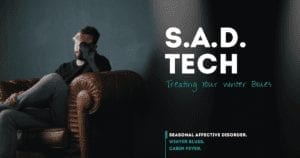Seasonal Affective Disorder also called the Winter Blues or Cabin Fever affects millions of people every year and is also misunderstood. Whether you’re suffering from Seasonal Affective Disorder (SAD) or just hate winter 一 Technology can help. Read on!
S.A.D. Tech: Treating Your Winter Blues
Seasonal Affective Disorder. Winter Blues. Cabin Fever.
Seasonal Depression Affects Millions
1 in 5 American adults has diagnosed seasonal depression
5% have seasonal affective disorder (SAD)
14% have the winter blues 一 a milder seasonal depression
1 in 4 American workers say January is their least happy month
1 in 3 say winter has a negative impact on their mood at work
It’s not just adults ー SAD affects 2 million children in the US, age 9-17
While the exact cause of SAD is unknown, the answer may lie in how light affects us
Beyond Sight: Light & The Human Brain
Intrinsically Photosensitive Retinal Ganglion Cells (ipRGCs)
Signals non-image-forming effects in response to environmental light
ipRGCs regulate:
Circadian rhythms
Pupil reflexes
Mood and energy level
SAD appears to be linked to the activation of ipRGCs, caused by either lack of daylight, or abnormal signalling
Less daylight in winter months makes ipRGCs fail to regulate circadian rhythms
Result: SAD sufferers experience:
Mood swings
Fatigue
Depression
Melatonin: The Sleep Hormone
Signals the body to calm down at night, enabling sleep
Melatonin regulates
Circadian rhythms
Body temperature
Blood pressure
Artificial light suppresses melatonin levels, affecting our perceptions of “night” and making harder to fall asleep
Winter brings more screen time and indoor lighting ー Delaying melatonin release and disrupting sleep
Result: Lack of sleep and increased risk of:
Depression
Diabetes
Heart disease
Vitamin D: The Sunshine Vitamin
Receptors for vitamin D are present in nearly all cells of the body
Vitamin D affects:
Bone growth
Mineral absorption
Immune function
When sunlight hits your skin, energy from ultraviolet B (UVB) rays activates vitamin D synthesis
Northern regions get fewer UVB rays, and winter keeps people indoors ー Robbing them of needed vitamin D
Result: Vitamin D deficiency causes:
Frequent illness
Fatigue
Depression
Light can have a big impact on your sleep, alertness, and mood
Make Light Work For You
Spending time outdoors may be the simplest way to get the light your body needs 一 But when winter weather makes that impossible, tech is here to help
Tech To Hack Light Patterns
Establishing the right lighting for each time of day will improve your sleep, mood, and alertness
Morning: Bright, cool light will help you feel alert and boost your mood
In a 2018 study, spending 30 minutes wearing blue light emitting goggles in the early morning significantly reduced participants sleepiness
Try This ー Philips Wake-Up Light: Slowly shifts from dim red to bright yellow light, mimicking sunrise
Evening: Block blue light to increase melatonin and get better sleep
Harvard researchers found that after 6.5 hours of exposure to blue light, participants’ circadian rhythms shifted by an average of 3 hours
Try This ー Philips HUE Smart Bulbs: Easily programmed to shift to warmer tones in the evening
Night: Use dim red night lights, or skip the night light all together
Just 8 lux, 2x the brightness of a typical night light, is enough light to disrupt sleep 一 Red light has the least impact on sleep
Try This ー SomniLight Night Light: Dim red light helps you see in the dark, without disrupting sleep
Tech To Block Blue Light
Blue light suppresses melatonin levels, helping you feel more alert during the day, but making harder to fall asleep at night
Blue-blocking glasses: Filtering or tinted lenses block out harmful blue light
For All-Day Wear一Bluwinx: Clear lenses filter out 59% of blue light
For Evening UseーUvex Skyper: Tinted lenses block 98% of blue light
Color filter apps: Automatically reduce screen brightness and shift to warmer colors at sunset
Night Shift ー Built-in feature for iOS and Mac
Twilight ー App for Android phones and tablets
F.lux ー App for Mac, Windows, and Linux
Tech to Get Some Sun
Bright Light Therapy*
Proven to treat SAD 一 Artificial sunlight triggers ipRGCs and resets your circadian rhythm
Choosing A Therapy Light
Light box: Widely available and affordable
Desk lamp: Easily blends into your decor
Visor: Allows patients to move freely during sessions
Look For These Features
2,500 – 10,000 lux: Low intensity lights require longer sessions
Short wavelength light: Cool tones, mimicking daylight, are best
UV filtering: Ultraviolet (UV) light can be damaging to your eyes
DMinder App
Diet alone won’t provide the Vitamin D your body needs ー The best source is sunlight
Location-based tracking of vitamin D from sun exposure
Notifications and forecasting of best time to go outside
Warnings help prevent sunburn based on skin type
For those living more than 37 degrees from the equator, it’s nearly impossible produce vitamin D from sunlight during winter months ー Experts recommend taking supplements to get 800 – 1,000 IU per day
Feeling blue this winter? These apps will help you get active and start feeling better
Apps For Your Winter Blues
WhatsMyM3
Track your moods for warning signs of SAD
Assesses your risk of depression with a research-based screening
Tracks scores over time, helping you know when to seek help
Fabulous
Get active with daily exercise and time outdoors
Created by Duke’s Behavioral Economics Lab
Helps users build toward healthy habits in small, easy steps
Pacifica
Focus on a healthy diet and lower stress
Tracks your mood, diet, caffeine intake, and sleep to identify patterns
Offers meditation, journal space, and other relaxation aides
TalkLife
Ask for the help and support of others
Online community provides the support of others with depression
Allows users to post anonymously, and chat with others
Whether you’re suffering from SAD or just hate winter 一 Technology can help
Sources:
http://www.vivo.colostate.edu/hbooks/pathphys/endocrine/otherendo/vitamind.html
https://www.health.harvard.edu/staying-healthy/blue-light-has-a-dark-side
https://www.ncbi.nlm.nih.gov/pmc/articles/PMC3047226/
https://www.ncbi.nlm.nih.gov/books/NBK19956/
https://www.ncbi.nlm.nih.gov/pubmed/30271376
http://rh-us.mediaroom.com/2018-01-08-Survey-Winter-Workplace-Blues-Hit-These-Cities-Most
https://books.google.com/books?id=dWIOJG7IIZIC&printsec=frontcover#v=onepage&q&f=false
https://www.thinkpacifica.com/
https://www.healthline.com/health/depression/top-iphone-android-apps#talklife
http://sleepeducation.org/treatment-therapy/bright-light-therapy/types-of-bright-light-therapy
https://www.mayoclinic.org/tests-procedures/light-therapy/about/pac-20384604
https://play.google.com/store/apps/details?id=com.urbandroid.lux
https://justgetflux.com/
https://bluwinx.com/
https://www.tuck.com/best-blue-light-blocking-glasses/
https://www.lifewire.com/reduce-eye-strain-with-blue-light-filter-apps-4134615
https://support.apple.com/en-us/HT207570
https://play.google.com/store/apps/details?id=com.urbandroid.lux
http://dminder.ontometrics.com/features.html#next-d
https://www.health.harvard.edu/staying-healthy/time-for-more-vitamin-d
https://thefabulous.co/alt/index-b.html?utm_expid=.OgmhsG9uSASylRxV0mscSQ.1&utm_referrer
https://itunes.apple.com/us/app/whatsmym3/id515945611?mt=8
https://www.health.harvard.edu/staying-healthy/blue-light-has-a-dark-side
https://www.somnilight.com/store/p21/Red_LED_Night_Light.html
https://www.ncbi.nlm.nih.gov/pmc/articles/PMC3047226/
https://www.ncbi.nlm.nih.gov/pubmed/30402294
https://www.nytimes.com/2017/02/10/realestate/light-bulbs-that-help-you-sleep.html
https://www.health.com/home/best-wake-up-light-alarm-clocks
https://www.healthline.com/nutrition/vitamin-d-from-sun#overview
Related:

